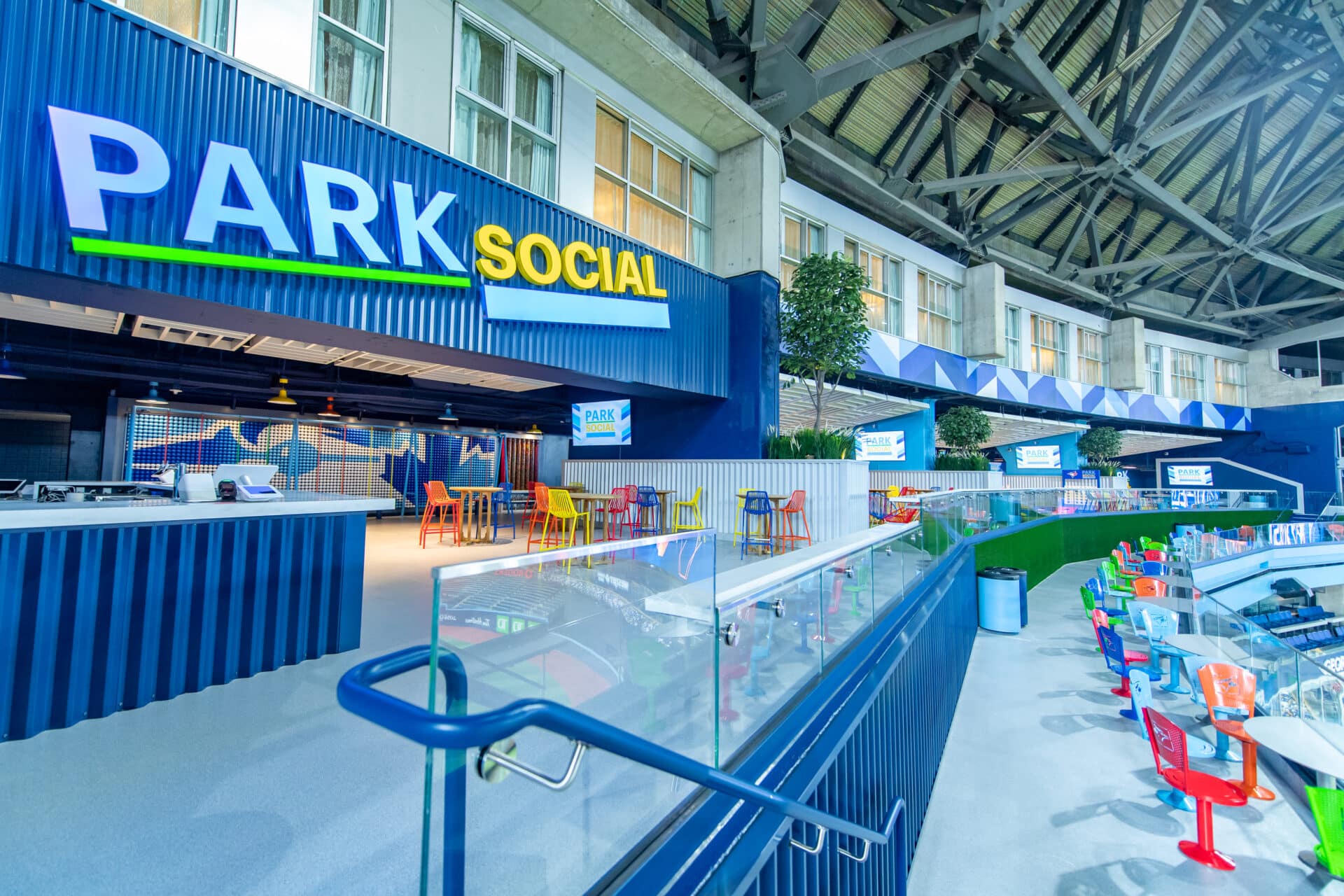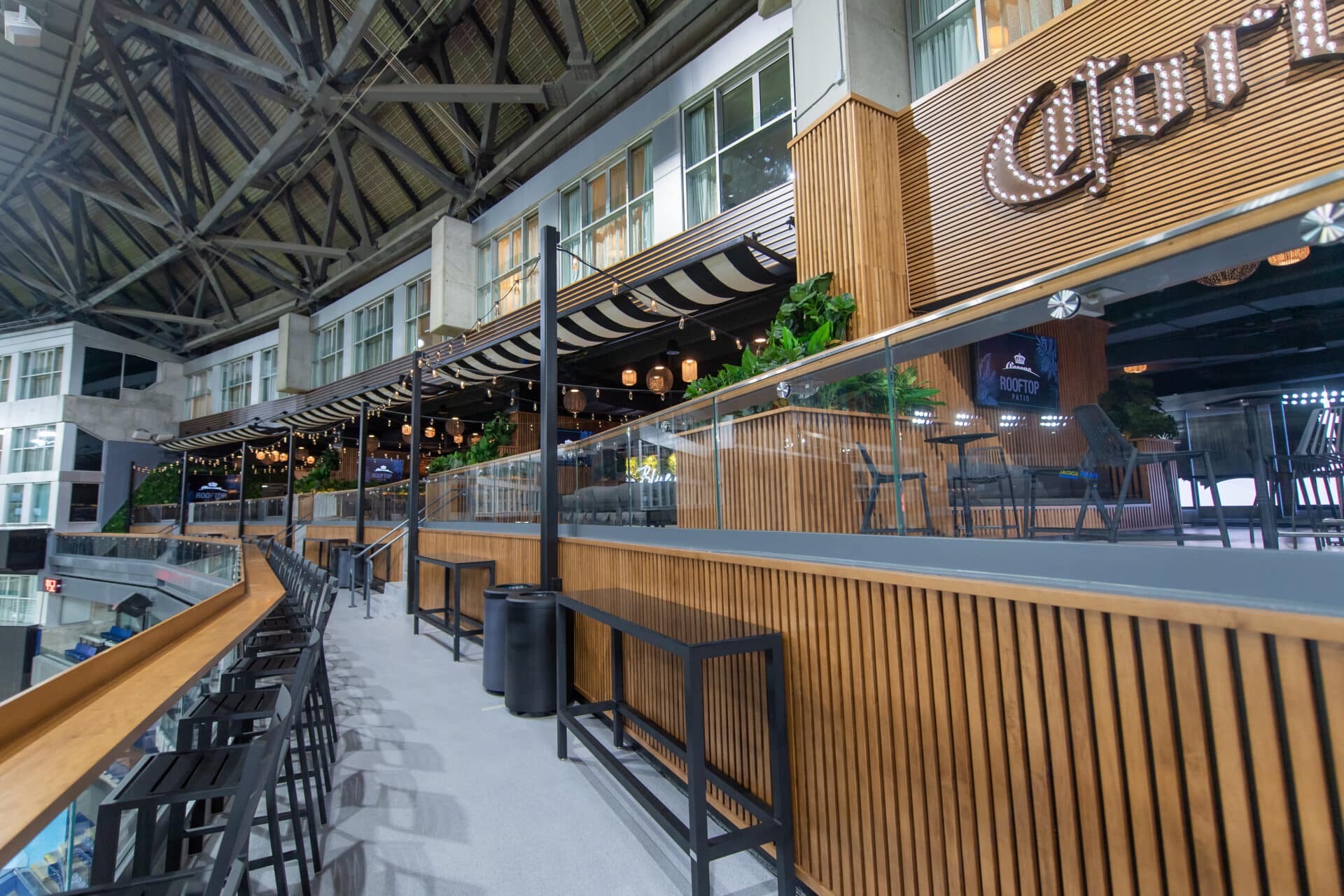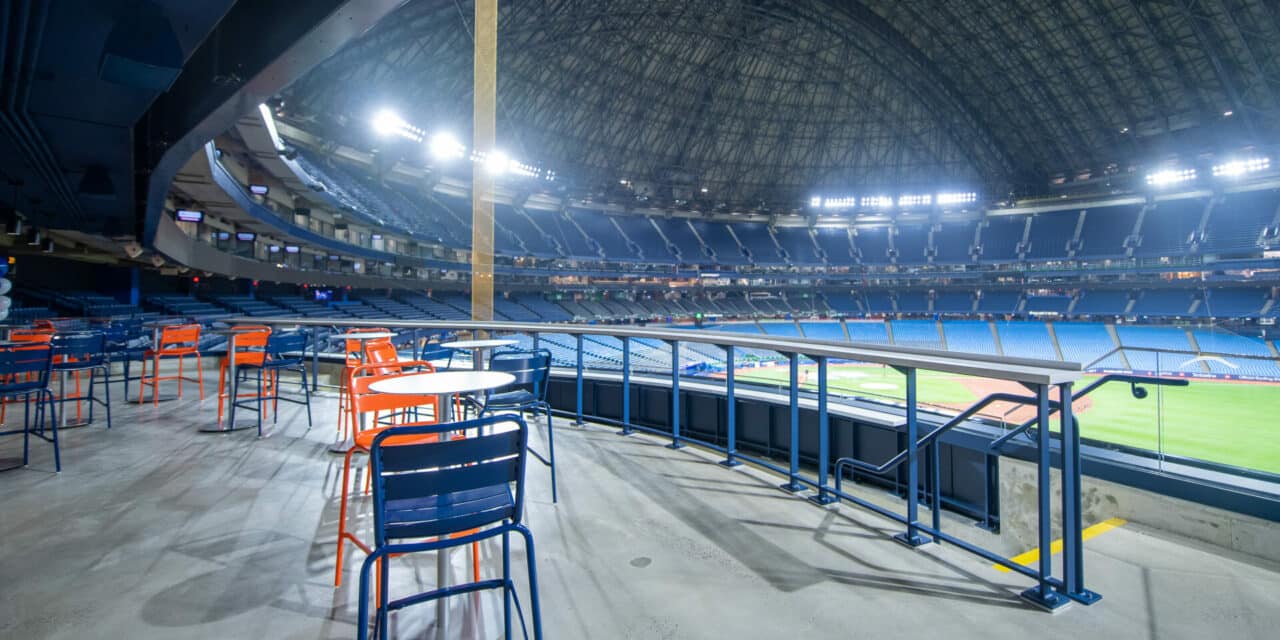SOCIAL BASES LOADED: Rogers Centre’s new social spaces include Schneiders Porch, located along the right field corner, offering various hot dog creations with direct bar access. It’s part of the Outfield District, designed to make the stadium feel more like a ballpark. (All photos courtesy venue)
Rogers Centre, home to the Toronto Blue Jays, Canada’s only Major League Baseball team, was the oldest stadium in North America to not go through significant upgrades, until this past offseason. From closer-to-the-action social spaces to arcade games and a stylish rooftop patio, those who want more than a traditional day out at the ballgame can do so.
“Rogers Centre was built as a one-size-fits-all experience and we know in 2023 that doesn’t work,” said Anuk Karunaratne, executive vice president of business operations for the Toronto Blue Jays. “People have all kinds of different expectations and if we don’t live up to it, they won’t come here. We have so many diehard fans, but we have so many people that either aren’t coming here or aren’t coming here as often because we haven’t done this. Now, they will.”
The former SkyDome opened in 1989 as the big leagues’ first stadium with a retractable roof, a cutting edge design in sports and entertainment. In addition to the Blue Jays, the Canadian Football League’s Toronto Argonauts were a tenant for 27 years before relocating to BMO Field, the city’s Major League Soccer facility. The dome also plays host to its fair share of stadium concerts.
With the $222 million (U.S.) privately funded renovation, a multiyear project, the goal is to modernize the city’s largest venue so it feels less like a multipurpose stadium and more like a ballpark. The first phase eliminated 3,000 seats, a 7% reduction, dropping capacity to about 41,500. The project as a whole is scheduled to be completed between 2024-2025.
“In sports, typically you’re seeing the timing of large scale renovations within a 20-year window. We were way past that,” Karunaratne said. The two phases address “the pain points” and should update the stadium for the immediate future, he said.

GO YARD: Park Social, showcasing food truck-style bites and games for the young at heart, is one of the five new “neighborhoods” at Rogers Centre.
“Through the outfield renovation in phase one and the next phase, we are addressing the infield bowl and the amenities underneath the bowl, as well as player facilities, premium and an entirely new seating bowl in the lower level,” he said. “Those changes will address the next 10 to 15 years. Then we’ll have a decision to make: do we keep going and continue renovating to address the next 30 years? Do we look at a new stadium? All of those are questions that have to be answered.”
The Blue Jays looked hard at building a new stadium before deciding in late 2021 that it was more financially feasible for the team and its parent company Rogers Communications, to overhaul the dome.
PCL Construction began structural demolition on Oct. 14, 2022, and the rebuild began in November with a tight window of fewer than five months before Opening Day to complete the first phase of construction in downtown Toronto.
All renovations take place during the offseasons.
The first phase encompasses the new Outfield District, which was unveiled during a media tour on April 6 and to the public on April 11 for the Jays’ home opener against the Detroit Tigers. The big reveal began with the on-field giant ribbon cutting by Mark Shapiro, Toronto Blue Jays president and CEO; Edward Rogers, chair of both the team and Rogers Communications; and Tony Staffieri, Rogers’ president and CEO.
“Today’s the start to unveil the transformation of this stadium to a ballpark,” Shapiro said. “It continues next season with the daunting task of transforming the lower bowl and continuing to transform the player amenities.”
Sports architect Populous, with a deep well of experience designing MLB parks, was charged with reshaping Rogers Centre into a baseball-first building, starting with the outfield seats. Previously, the outfield as a whole was a uniform system across multiple floors. There was no real differentiation between the 100 level, closest to the field, to the 500 level in the upper deck, all covered by a moving roof.
“That’s what makes baseball so interesting to design for, is they all have their own character,” said Derek Sommers, an associate principal at Populous who worked on the upgrades. “Rogers Centre is a different building than a lot of other venues in MLB. Some of our research involved the development of the city itself. The ‘neighborhoods’ idea started with this trend throughout Toronto’s history that it’s an amalgam of different communities that only in recent history have come together to create this great, unified city.”
Karunaratne said he visited most MLB parks as well as NFL stadiums and big league arenas to get ideas for refreshing Rogers Centre. Many ballparks now have outfield social spaces near the bullpen, which wasn’t the case in Toronto.
“While we drew inspiration from other places, our goals were, how do we bring the city into the ballpark? How do we create distinct and diverse experiences?” he said. “We didn’t want them to feel cookie cutter. We wanted each space to have an identity that can stand alone.”
Over the past decade, there are plenty of examples to point to for general admission retrofits to outfield areas.
Karunaratne cited The Rooftop at Coors Field in Denver and The ‘Pen at T-Mobile Park in Seattle for bringing fans closer to the action in the outfield and integrating local food and beverage offerings into those destinations.
In the American League East, division rival the Baltimore Orioles built the Roof Deck in center field with tiered GA seating, supported by a central bar behind the seats. The Boston Red Sox, another divisional foe, have developed multiple outfield hangouts at Fenway Park, such as the Sam Deck, 521 Overlook and the Green Monster, with seating, a bar and concessions on top of the iconic left-field wall.
The same is true at Wrigley Field in Chicago, in a simpler fashion. Over the past several years, the Cubs, with Populous as their architect, expanded the most famous outfield bleacher section in baseball. There’s lounge seats, new bars and precious shade beneath the main videoboard in left-center field. The Bud Patio, a group space, frames part of right field. Behind the bleachers in straightaway center, there is space to eat, drink and gaze below at the grizzled T-shirt vendors, Murphy’s Bleachers Bar and the El train tracks.
In Toronto, the Outfield District materialized, divided into five primary neighborhoods: the Corona Rooftop Patio and Park Social, at opposite corners of the upper deck; The Stop in center field on the main concourse behind the batter’s eye; The Catch, above the visitors bullpen in right field; and WestJet Flight Deck, an existing space midlevel in center field that’s gone through some tweaks in the offseason.

BATTER UP: A tour of Rogers Centre’s new “neighborhoods” and social spaces included various food and beverage samplings, from poutine hotdogs, jerk chicken nachos, grilled cheese sandwiches and honey mustard popcorn to adult beverages such as sangria, mojitos and hard iced tea. Aramark runs the food service.
General admission for the Outfield District costs $15 with 1,000 of those tickets available. Fans with reserved seating can also access the new spaces.
The rooftop patio, in right field, facing Toronto’s skyline, will offer live music beneath the CN Tower and a summer patio menu. Park Social, its counterpart in left field, will showcase food truck-style bites and games for kids. The Stop has a bar with food options; it’s named for a space that was originally planned as a transit stop when the stadium opened. The flight deck features retro arcade games and a brewery-style menu.
“We concentrated on baseball being a summertime game, so we embraced a lot of these activities in the outfield tied to the energy of a ballgame with the roof open,” Sommers said. “We focused on parks, patios and rooftops. If you look out into the city, you see this beautiful collection of the way various buildings adapted their own social spaces at different levels throughout the skyline. That’s one of the reasons we started thinking about these outdoor social zones, even though when the roof is closed, it’s an indoor environment.”
The 500 level, at the dome’s highest point, is where that feeling of being outdoors will be most effective on days when the roof is open, he said. Over the past decade, the weather has been nice enough in Toronto that the roof is open for roughly two-thirds of the Jays’ 81 home games, give or take.
Regardless of whether the roof is open or closed, the new spaces should work, decorated with festive materials such as artificial turf, stringing lanterns and lawn furniture that at least gives the impression that you’re part of the outdoors and with all the energy that comes with it, Sommers said.
The Outfield District extends to Schneiders Porch, mid level in the right field corner; Rogers Landing, right-field corner beside the visitors bullpen; bleacher seating lower level in the bowl behind the visitors bullpen; plus left and right field balconies and drink rails. Schneiders offers various hot dog creations with direct bar access. Rogers Landing provides a great spot for fans to bring their gloves in a space that’s become a sweet spot for home runs.
The bleachers and balconies were created for hardcore fans to watch opposing pitchers warm up. New concessions technology is also part of the first phase with Tap N Go, an automated market by section 104, and a pair of Walk Thru Bru locations, focusing on self-serve beverages, by sections 125 and 519.
Fan access to observing bullpen action is another key piece of phase one, providing a new experience that’s common at many parks, but to this point, was not a feature at Rogers Centre. Some are standing room spaces “cradling” the bullpens, Sommers said. In other cases, it’s conventional seating bringing fans closer to those field-level areas.
(VenuesNow Senior Editor Don Muret contributed to this story.)







